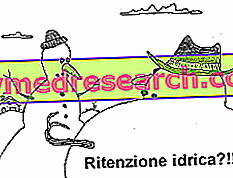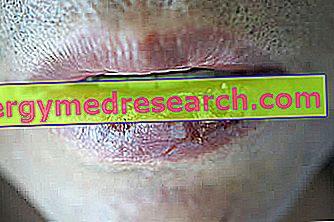What's this ?
The term cholecystitis defines any generic inflammation of the gallbladder, otherwise known as the gallbladder. It can occur in acute or chronic form and its origin can recognize different causes. Data in hand, in over 85-90% of cases, cholecystitis is associated with biliary lithiasis, that is, the presence of calculi in the gallbladder and / or biliary tract. We therefore talk about calculocyte cholecystitis.

Cholecystitis and gallstones
Let us briefly recall how gallstones develop as a result of reduced solubility of cholesterol and bile salts in bile, normally guaranteed by the generous presence of phospholipids. When this equilibrium is broken, the solubility of these components fails and crystalline precipitations are formed which, when combined, give rise to the calculations. Particularly at risk of stones are women compared to men, obese compared to normal weight, individuals who experience rapid weight loss, individuals with a family member suffering from gallbladder stones, the recent pregnancy, the history of gall bladders previous, intermediate and old age (the average age of onset of calcified cholecystitis is around 60 years).
The pathogenetic mechanisms through which a calculation can give rise to cholecystitis are various and include the direct mechanical insult, of abrasive or pressure origin, of the mucous membrane of the gall bladder. In vogue especially in the past, another hypothesis holds that cholelithitis due to cholelithiasis derives from the proliferation of bacteria inside the bile fluid preserved in the gall bladder, and is considered beyond measure for the presence of a calculus (in the cystic duct or in the choledochus) which prevents its normal outflow into the intestine. The bacteria would arrive in the gallbladder by going up the bile canaliculi from the intestine or by descending them from the liver for intestinal absorption through the portal circulation, or again by blood or lymphatic route. Biliary stasis would cause cholecystitis also through a chemical insult to the gall bladder walls, mediated by bile components reabsorbed by the gallbladder mucosa. Still of chemical nature is the insult deriving from the rise of pancreatic juices which, with their digestive enzymes, undermine the integrity of the gallbladder mucosa. Finally, the picture is complicated by the reduced blood supply to the gall bladder (ischemia) linked to the increase in intraluminal pressure with compression of blood vessels. The consequent ischemia, in the absence of treatment, may give rise to the feared complications of cholecystitis: necrosis of the gallbladder wall until its perforation and extravasation of bile with chemical and / or bacterial peritonitis.
Alitiasic cholecystitis (or acalcolotica)
It is a form of cholecystitis independent of the presence of stones, although the finding of biliary stasis is common. Rather than in the presence of a calculation, this phenomenon is to be found in other causes: such as debilitation, sepsis, prolonged lodging, major surgical interventions, major traumas, especially if abdominals, fractures, burns and prolonged parenteral nutrition. More common in elderly males, alitiasic cholecystitis can also be favored by diabetes, acute cardiac events, sickle cell anemia and bacterial, viral or protozoan infections - eg. salmonella, typhoid, cytomegalovirus, cryptosporidia or microsporidia - especially in immunocompromised patients. Advanced age and male sex seem to be risk factors; in children, most cases of cholecystitis are acalcolotic.
We should also mention all the causes of obstruction of the cystic duct and of the bile duct of a non-calculative nature (tumor processes, fibrosis, congenital anomalies) as responsible for alitiasic cholecystitis.
Symptoms
To learn more: Cholecystitis symptoms
Acute cholecystitis is typically accompanied by symptoms such as fever and pain in the upper right quadrant of the abdomen and / or the upper middle part, which can sometimes extend posteriorly.
Unlike the biliary colic, the pain is persistent and continuous even after the acute episode, although it diminishes over time. The character of rapid regression and possible intermittence that characterizes the typical biliary colic pain is therefore less.
The pain symptoms associated with cholecystitis is exacerbated by the doctor's palpation of the gallbladder region, and its origin is often associated with a fatty meal.
The intensity of pain does not necessarily correlate with the severity of cholecystitis, while the relationship is more truthful with fever, which - always present - is generally modest in mild forms, and decidedly higher in necrotic or purulent forms.
In addition to pain, fever and chills, anorexia (meaning lack of appetite), nausea and vomiting are also common.
Jaundice (yellowing of the skin and ocular sclerae), more or less evident, is typically related to the forms of lithiasis cholecystitis in which the calculi are found in the choledochus, preventing the enteric outflow also of bile of direct hepatic origin. Jaundice may also depend on the compression of the main bile duct by a hyper-distended gall bladder or by dangerous abscess collection.
Chronic cholecystitis, which can result from repeated episodes of acute inflammation or chronic irritation of another nature, may be asymptomatic.
Diagnosis
Characteristic is the elevation of neutrophil leukocytes, demonstrable with a simple blood test, together with that of the ESR (erythrocyte sedimentation rate), of the alkaline phosphatase and to the possible hyperbilirubinemia, in particular of the direct quota in case of choledochus lithiasis.
To all this, the slight increase in transaminases and serum amylases may be associated.
The anamnesis and the clinical picture, together with laboratory tests and instrumental investigations (ultrasound, CT scan) allow the diagnosis of cholecystitis.
Therapy
To learn more: Drugs for the treatment of cholecystitis - Cholecystectomy
The therapy of cholecystitis must be immediately implemented, in order to avoid the risk of serious complications (gangrene and perforation. In addition to physical rest (in bed) and intestinal rest (fasting) with maintenance or reintegration of the salt and water balance, the treatment of cholecystitis foresees the use of antispasmodic drugs (scopolamine butylbromide), analgesics (meperidine or pethidine, diclofenac), and antibiotics (piperacillin, ampicillin, netilmicin, cephalosporins) .After the acute episode it is good to adopt, always as a general cure, a low diet lipid and protein content.
In the presence of a rather severe or complicated cholecystitis (empyema - collection of pus due to the presence of pyogenic bacteria - hydrops - accumulation of liquids and mucus with organ hyperextension - gangrene, gallbladder perforation, peritonitis), a cholecystectomy is necessary. urgency, a surgical intervention - nowadays performed by laparoscopy - through which the gallbladder is removed. The minimally invasive procedure, together with the fact that the gall bladder is an organ of relative importance, ensures complete recovery and ample recovery, effectively eliminating the risk of recurrence without significantly affecting the patient's future health.



